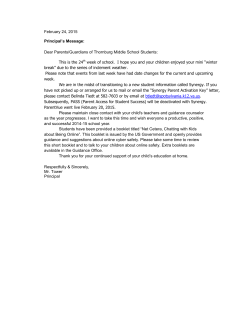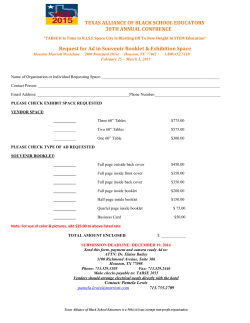
2015 - CEMC - University of Waterloo
The CENTRE for EDUCATION in MATHEMATICS and COMPUTING cemc.uwaterloo.ca Fryer Contest (Grade 9) Thursday, April 16, 2015 (in North America and South America) Friday, April 17, 2015 (outside of North America and South America) Time: 75 minutes ©2015 University of Waterloo Do not open this booklet until instructed to do so. Number of questions: 4 Each question is worth 10 marks Calculators are allowed, with the following restriction: you may not use a device that has internet access, that can communicate with other devices, or that contains previously stored information. For example, you may not use a smartphone or a tablet. Parts of each question can be of two types: 1. SHORT ANSWER parts indicated by • worth 2 or 3 marks each • full marks given for a correct answer which is placed in the box • part marks awarded only if relevant work is shown in the space provided 2. FULL SOLUTION parts indicated by • • • • worth the remainder of the 10 marks for the question must be written in the appropriate location in the answer booklet marks awarded for completeness, clarity, and style of presentation a correct solution poorly presented will not earn full marks WRITE ALL ANSWERS IN THE ANSWER BOOKLET PROVIDED. • Extra paper for your finished solutions supplied by your supervising teacher must be inserted into your answer booklet. Write your name, school name, and question number on any inserted pages. √ • Express calculations and answers as exact numbers such as π + 1 and 2, etc., rather than as 4.14 . . . or 1.41 . . ., except where otherwise indicated. Do not discuss the problems or solutions from this contest online for the next 48 hours. The name, grade, school and location of some top-scoring students will be published on our website, cemc.uwaterloo.ca. In addition, the name, grade, school and location, and score of some top-scoring students may be shared with other mathematical organizations for other recognition opportunities. NOTE: 1. Please read the instructions on the front cover of this booklet. 2. Write all answers in the answer booklet provided. 3. For questions marked , place your answer in the appropriate box in the answer booklet and show your work. 4. For questions marked , provide a well-organized solution in the answer booklet. Use mathematical statements and words to explain all of the steps of your solution. Work out some details in rough on a separate piece of paper before writing your finished solution. Diagrams are not drawn to scale. They are intended as aids only. While calculators may be used for numerical calculations, other mathematical steps must be shown and justified in your written solutions and specific marks may be allocated for these steps. For example, while your calculator might be able to find the x-intercepts of the graph of an equation like y = x3 − x, you should show the algebraic steps that you used to find these numbers, rather than simply writing these numbers down. No student may write more than one of the Fryer, Galois and Hypatia Contests in the same year. 5. 6. 7. r 1. A company builds cylinders. Its Model A cylinder has radius r = 10 cm and height h = 16 cm. h Volume of a Cylinder: V = πr2 h (a) What is the volume in cm3 of a Model A cylinder? (b) The company also builds a Model B cylinder having a radius of 8 cm. Each Model B cylinder has the same volume as each Model A cylinder. What is the height in cm of a Model B cylinder? (c) The company makes a rectangular box, called Box A, that holds six Model A cylinders. The cylinders are placed into the box vertically and tightly packed, as shown. Determine the volume in cm3 of Box A. (d) The company makes another rectangular box, called Box B, that holds six Model B cylinders. The cylinders are placed into the box vertically and tightly packed, just as was shown in part (c). State whether the volume of Box B is less than, greater than, or equal to, the volume of Box A. 2. In Canada, a quarter is worth $0.25, a dime is worth $0.10, and a nickel is worth $0.05. (a) Susan has 3 quarters, 18 dimes and 25 nickels. What is the total value of Susan’s coins? (b) Allen has equal numbers of dimes and nickels, and no other coins. His coins have a total value of $1.50. How many nickels does Allen have? (c) Elise has $10.65 in quarters and dimes. If Elise has x quarters and 2x + 3 dimes, what is the value of x? 3. n(n + 1) . 2 For example, to calculate the sum of the first 4 positive integers, we evaluate 4(4 + 1) 1+2+3+4= = 10. 2 (a) What is the sum of the first 200 positive integers, A formula for the sum of the first n positive integers is 1 + 2 + 3 + · · · + n = 1 + 2 + 3 + · · · + 198 + 199 + 200 ? (b) Calculate the sum of the 50 consecutive integers beginning at 151, that is, 151 + 152 + 153 + · · · + 198 + 199 + 200 . (c) Starting with the sum of the first 1000 positive integers, 1+2+3+· · ·+999+1000, every third integer is removed to create the new sum 1 + 2 + 4 + 5 + 7 + 8 + 10 + 11 + · · · + 998 + 1000 . Calculate this new sum. 4. The token • is placed on a hexagonal grid, as shown. At each step, the token can be moved to an adjacent hexagon in one of the three directions -, ↑, %. (The token can never be moved in any of the three directions, ., ↓, &.) A C (a) What is the minimum number of steps required to get the token to the hexagon labelled A? (b) With justification, determine the maximum number of steps that can be taken so that the token ends at A. (c) Using exactly 5 steps, the token can end at the hexagon labelled C in exactly 20 different ways. Using exactly 5 steps, the token can end at n different hexagons in at least 20 different ways. Determine, with justification, the value of n. 2015 Fryer Contest (English) The CENTRE for EDUCATION in MATHEMATICS and COMPUTING cemc.uwaterloo.ca For students... Thank you for writing the 2015 Fryer Contest! Each year, more than 200 000 students from more than 60 countries register to write the CEMC’s Contests. Encourage your teacher to register you for the Canadian Intermediate Mathematics Contest or the Canadian Senior Mathematics Contest, which will be written in November 2015. Visit our website cemc.uwaterloo.ca to find • Free copies of past contests • Math Circles videos and handouts that will help you learn more mathematics and prepare for future contests • Information about careers in and applications of mathematics and computer science For teachers... Visit our website cemc.uwaterloo.ca to • Obtain information about our 2015/2016 contests • Register your students for the Canadian Senior and Intermediate Mathematics Contests which will be written in November • Look at our free online courseware for senior high school students • Learn about our face-to-face workshops and our web resources • Subscribe to our free Problem of the Week • Investigate our online Master of Mathematics for Teachers • Find your school’s contest results
© Copyright 2025













